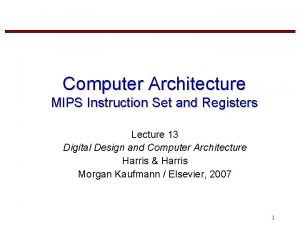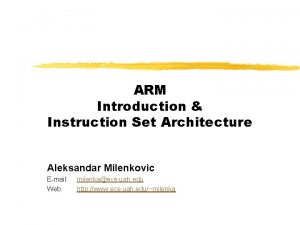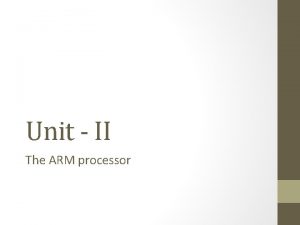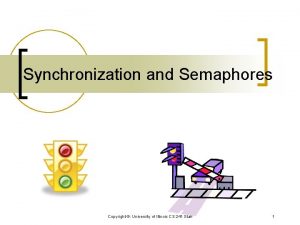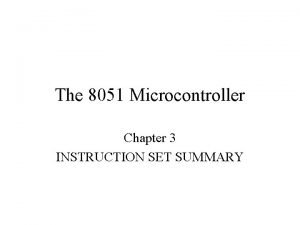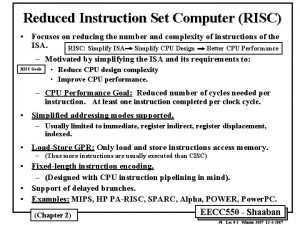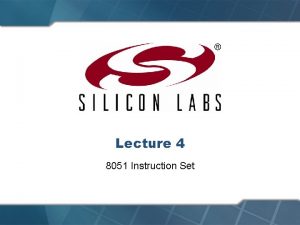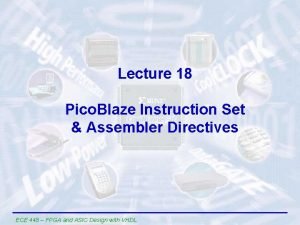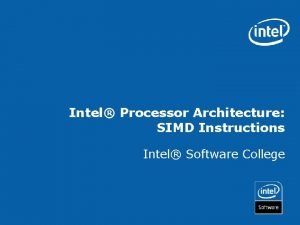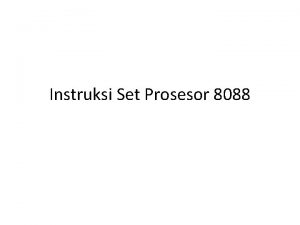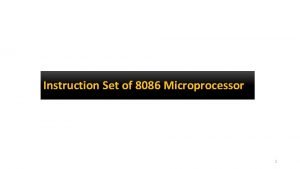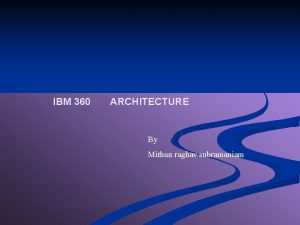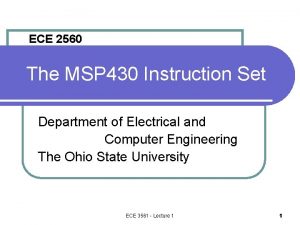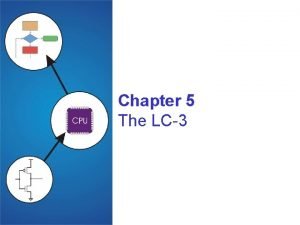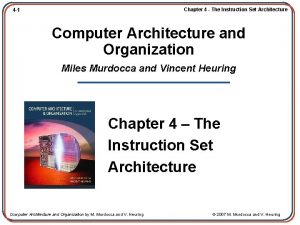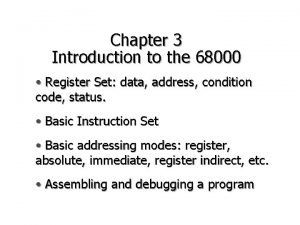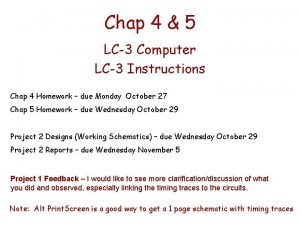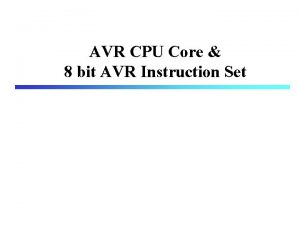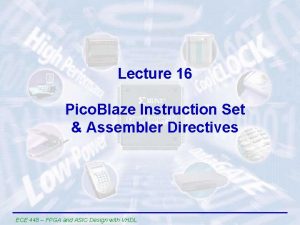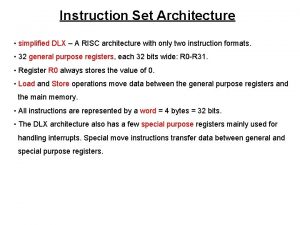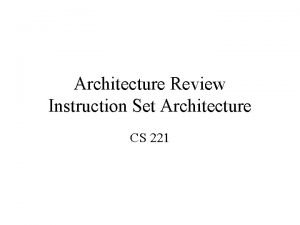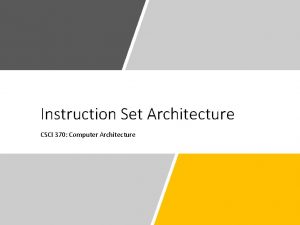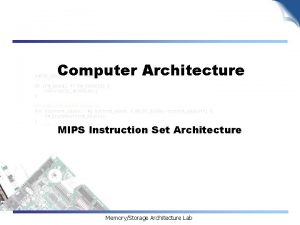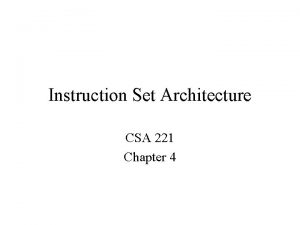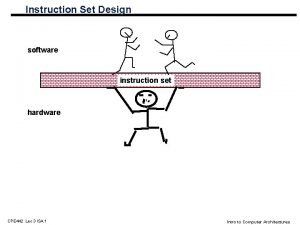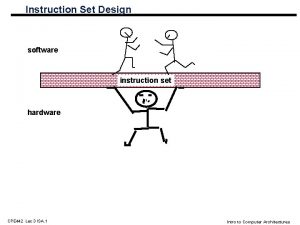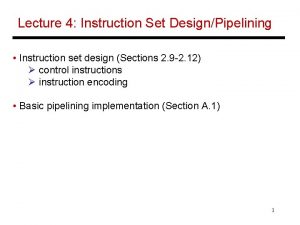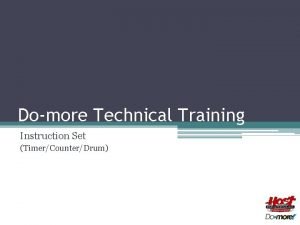Instruction Set Architecture and Principles Chapter 2 Instruction










































- Slides: 42

Instruction Set Architecture and Principles Chapter 2

Instruction Sets • What’s an instruction set? – Set of all instructions understood by the CPU – Each instruction directly executed in hardware • Instruction Set Representation – Sequence of bits, typically 1 -4 words – May be variable length or fixed length – Some bits represent the op code, others represent the operand

Instruction Set Affects CPU Performance • Recall – Exec. Time = Instruction_Count * CPI * Cycle_Time – Instruction Set is at the heart of the matter! Source Code Instruction Set Compiler Instr Fetch Instr Decode Object Code Instruction_Count Instr Execute CPI and Cycle Time

Classes of Instruction Set Architectures • Stack Based – Implicitly use the top of a stack • PUSH X, PUSH Y, ADD, POP Z • Z=X+Y • Accumulator Based – Implicitly use an accumulator • LOAD X, ADD Y, STORE Z • GPR – General Purpose Registers – Operands are explicit and may be memory or registers • • LOAD R 1, X LOAD R 2, Y ADD R 1, R 2, R 3 STORE R 1, Z or LOAD R 1, X ADD R 1, Y STORE R 1, Z

Comments on Classifications of ISA • Stack-based generates short instructions (one operand) but programming may be complex, lots of stack overhead • Accumulator-based also has complexities for juggling different data values • GPR – most common today – Allows large number of registers to exist to hold variables – Compiler gets the job today of allocating variables to registers

Comparison Details PRO CON STACK Simple Address format Effective decode Short Instruction high code density Stack bottleneck Lack of random access Many instr’s needed for some code ACC Short Instrucions High code density Lots of memory traffic GPR Lots of code generation options Efficiencies possible Larger code size Possibly complex effective address calculations

How Many Operands? • Two or Three? – Two : Source and Result – Three: Source 1, Source 2, and Result • Tradeoffs – Two operand ISA requires more temporary instructions (e. g. Z = X + Y can’t be done instruction) – Three operand ISA supports fewer instructions but increases the instruction complexity and size • Also must consider the types of operands allowed – Register to Register, Register to Memory, Memory to Memory – Instruction density, memory bottlenecks, CPI variations!

Register-Register (0, 3) • (m, n) means m memory operands and n total operands in an ALU instruction – Pure RISC, register to register operations – Advantages • Simple, fixed length instruction encodings • Decode is simple • Uniform CPI – Disadvantages • Higher Instruction Count • Some instructions are short and bit encodings may be wasteful

Register-Memory (1, 2) • Register – Memory ALU Architecture • In later evolutions of RISC and CISC • Advantages – Data can be accessed without loading first – Instruction format easy to encode – Good instruction density • Disadvantages – Source operand also destination, data overwritten – Need for memory address field may limit # registers – CPI varies by operand location

Memory-Memory (3, 3) • True memory-memory ALU model, e. g. full orthogonal CISC architecture • Advantages – Most compact instruction density, no temporary registers needed • Disadvantages – – Memory access create bottleneck Variable CPI Large variation in instruction size Expensive to implement • Not used in today’s architectures

Memory Addressing • What is accessed - byte, word, multiple words? – today’s machine are byte addressable, due to legacy issues • But main memory is organized in 32 - 64 byte lines – matches cache model – Retrieve data in, say, 4 byte chunks • Alignment Problem – accessing data that is not aligned on one of these boundaries will require multiple references • E. g. fetching 16 bit integer at byte offset 3 requires two four byte chunks to be read in (line 0, line 1) – Can make it tricky to accurately predict execution time with mis-aligned data – Compiler should try to align! Some instructions autoalign too

Big-Endian vs. Little-Endian • How is data stored? – E. g. given 0 x. ABCD • Big-Endian – Store MSByte first (AB CD) – Hex dumps a little easier to read – Intel • Little-Endian – Store LSByte first (CD AB) – May still get right value when reading different word sizes – Motorola • Computers internally know how data is stored, so does it matter? – Yes, networks and sending data byte by byte – May need functions, like htons – Some systems have an Endian control bit to select

Addressing Modes • The addressing mode specifies the address of an operand we want to access – Register or Location in Memory – The actual memory address we access is called the effective address • Effective address may go to memory or a register array – typically dependent on location in the instruction field – multiple fields may combine to form a memory address – register addresses are usually simple - needs to be fast • Effective address generation is important and should be fast! – Falls into the common case of frequently executed instructions

Memory Addressing Mode Example Meaning When used Register Add R 4, R 3 Regs[R 4]+ Regs[R 3] Value is in a register Immediate Add R 4, #3 Regs[R 4] + 3 For constants Displacement Add R 4, 100(R 1) Regs[R 4] + Mem[100+Regs[R 1]] Access local variables Indirect Add R 4, (R 1) Regs[R 4]+ Mem[Regs[R 1]] Pointers Indexed Add R 3, (R 1+R 2) Regs[R 3] Mem[Regs [R 1]+Regs[R 2]] Traverse an array Direct Add R 1, $1001 Regs[R 1] + Mem[1001] Static data, address constant may be large

Memory Addressing Mode Example Meaning When used Memory Indirect Add R 1, @(R 3) Regs[R 1] + Mem[Regs[R 3]]] *p if R 3=p Autoinc Add R 1, (R 2)+ Regs[R 1]+ Mem[Regs[R 2]], Regs[R 2]+1 Stepping through arrays in a loop Autodec Add R 1, (R 2)- Regs[R 1]+ Mem[Regs[R 2]], Regs[R 2]-1 Same as above. Can push/pop for a stack Scaled Add R 1, 100(R 2)[R 3] Regs[R 1]+ Mem[100+Regs[R 2] + Regs[R 3] * d] Index arrays by a scaling factor, e. g. word offsets

Which modes are used? • VAX supported all modes! • Dynamic traces, frequency of modes collected – Memory Indirect • Te. X: 1%, SPICE: 6%, gcc: 1% – Scaled • Te. X: 0%, SPICE: 16%, gcc: 6% – Register Deferred • Te. X: 24%, SPICE: 3%, gcc: 11% – Immediate • Te. X: 43%, SPICE: 17%, gcc: 39% – Displacement • Te. X: 32%, SPICE: 55%, gcc: 40% • Results say: support displacement, immediate, fast! • WARNING! Role of the compiler here?

Displacement Addressing Mode • According to data, this is a common case – so optimize for it • Major question – size of displacement field? – If small, may fit into word size, better instruction density – If large, allows larger range of accessed data – To resolve, use dynamic traces once again to see the size of displacement actually used

Displacement Traces % of Displacement Number of bits needed for displacement (lg d)

Immediate Addressing Mode • Similar issues as with displacement; how big should the operands be? What size data do we use in practice? • Tends to be used with constants – Constants tend to be small? • What instructions use immediate addressing? – – Loads: 10% Int, 45% FP Compares: 87% Int, 77% FP ALU: 58% Int, 78% FP All Instructions: 35% Int, 10% FP

Immediate Addressing Mode % # bits needed for an immediate value

Instruction Set Optimization • See what instructions are executed most frequently, make sure they are fast! • Intel x 86: – – – – – Load Conditional Branch Compare Store Add AND SUB Move Reg To Reg Call Ret 22% 20% 16% 12% 8% 6% 5% 4% 1% 1%

Control Flow • Transfers or instructions that change the flow of control • Jump – unconditional branch – How is target specified? How far away from PC? • Branch – when condition is used – How is condition set? • Calls – Where is return address stored? – How are parameters passed? • Returns – How is the result returned? • What work does the linker have to do?

Biggest Deal is Conditional Branch

Branch Address Specification • Effective address of the branch target is known at compile time for both conditional and unconditional branches – as a register containing the target address – as a PC- relative offset • Consider word length addresses, registers, and instructions – full address desired? Then pick the register option. – BUT - setup and effective address will take longer. – if you can deal with smaller offset then PC relative works – PC relative is also position independent - so simple linker duty, preferred when possible • Do more measurements to see what’s possible!

Branch Distances % Bits of branch displacement

Condition Testing Options Name Test Pro Condition Code Special PSW bits Conditions may set by ALU be set for “free” Extra state to maintain, constrain ordering of instructions Condition Register Comparison result put in register, test register Simple, less ordering constraints Uses up a register Compare and Branch Compare is part of branch One instruction instead of two for a branch May be too much work per instruction

What is compared? • < , >= – Int: 7% Float: 40% • >, <= – Int: 7% Float: 23% • ==, != – Int: 86% Float: 37% • Over 50% of integer compares were to test for equality with 0

Branch Direction • GCC – Backward branches: 24% – Branches taken: 54% • Spice – Backward branches: 31% – Branches taken: 51% • Te. X – Backward branches: 17% – Branches taken: 54% • Most backward branches are loops – taken about 90% • Branch statistics are both compiler and application dependent • Loop optimizations may have large effect • We’ll see the role of this later with branch prediction and pipelining

Operand Type and Size • Operands may have many types, how to distinguish which? • Annotate with a tag interpreted by hardware – Not used anymore today • The opcode also encodes the type of the operand – Amounts to different instructions per type • Typical types – – – character – byte (UNICODE? ) short integer – two bytes, 2’s complement integer - one word, 2’s complement float - one word - IEEE 754 double - two words - IEEE 754 BCD or packed decimal

Most Frequently Used Operand Types • Double word – Te. X 0%, Spice 66%, GCC 0% • Word – Te. X 89%, Spice 34%, GCC 91% • Halfword – Te. X 0%, Spice 0%, GCC 4% • Byte – Te. X 11%, Spice 0%, GCC 5% • Move underway now to 64 bit machines – BCD likely to go away – larger offsets and immediates is likely – usage of 64 and 128 bit values will increase

Encoding the Instruction Set • How to actually store, in binary, the instructions we want – Depends on previous discussion, operands, addressing modes, number of registers, etc. – Will affect code size, and CPI • Tradeoffs: – Desire to have many registers, many addressing modes – Desire to have the average instruction size small – Desire to encode into lengths the hardware can easily and efficiently handle • Fixed or variable length? • Remember data delivered in blocks of cache line sizes

Instruction Set Encoding Options Variable (e. g. VAX) Op. Code and # of ops Operand 1 Operand 2 … Operand N Fixed (e. g. DLX, SPARC, Power. PC) Op. Code Operand 1 Operand 2 Operand 3 Hybrid (e. g. x 86, IBM 360) Op. Code Operand 1 Operand 2 Op. Code Instruction Size? Complexity?

Role of the Compiler • Role of the compiler is critical – Difficult to program in assembly, so nobody does it – Certain ISA’s make assembly even more difficult to optimize – Leave it to the compiler • Compiler writer’s primary goal: – correctness • Secondary goal: – speed of the object code • More minor goals: – speed of the compilation – debug support – Language interoperability

Compiler Optimizations • High-Level – Done on source with output fed to later passes – E. g. procedure call changed to inline • Local – Optimize code only within a basic block (sequential fragment of code) – E. g. common subexpressions – remember value, replace with single copy. Replace variables with constants where possible, minimize boolean expressions • Global – Extend local optimizations across branches, optimize loops – E. g. , remove code from loops that compute same value on each pass and put it before the loop. Simplify array address calculations.

Compiler Optimizations (cont) • Register Allocation – What registers should be allocated to what variables? – NP Complete problem using graph coloring. Must use an approximation algorithm • Machine-dependent Optimization – Use SIMD instructions if available – Replace multiply with shift and add sequence – Reorder instructions to minimize pipeline stalls

Example of Register Allocation c = ‘S’ ; sum = 0 ; i=1; while ( i <= 100 ) { sum = sum + i ; i=i+1; } square = sum * sum; print c, sum, square; [100] [101] [102] [103] [104] c = ‘S’ sum = 0 i = 1 label L 1: if i > 100 goto L 2 false true [108] [109] [110] [105] [106] [107] sum = sum + i i = i + 1 goto L 1 label L 2: square = sum * sum print c, sum, square

Example : Register Allocation • Assume only two registers available, R 1 and R 2. What variables should be assigned, if any? Variable c sum i square Register ? ? c = ‘S’ ; sum = 0 ; i=1; while ( i <= 100 ) { sum = sum + i ; i=i+1; } square = sum * sum; print c, sum, square;

Example : Register Allocation • Sum and I should get priority over variable C • Reuse R 2 for variables I and square since there is no point in the program where both variables are simultaneously live. Variable c sum i square #Uses 1 103 301 1 Register none R 1 R 2 c = ‘S’ ; sum = 0 ; i=1; while ( i <= 100 ) { sum = sum + i ; i=i+1; } square = sum * sum; print c, sum, square;

Register Allocation: Constructing a Graph • A node is a variable (may be temporary) that is a candidate for register allocation • An edge connects two nodes, v 1 and v 2, if there is some statement in the program where variables v 1 and v 2 are simultaneously live, meaning they would interfere with one another • Once this graph is constructed, we try to color it with k colors, where k = number of free registers. Coloring means no connecting nodes may be the same color. The coloring property ensures that no two variables that interfere with each other are assigned the same register.

Register Allocation Example s 1 s 7 s 2 s 1 = ld(x) s 2 = s 1 + 4 s 3 = s 1 8 s 4 = s 1 - 4 s 3 s 6 s 5 s 4 s 5 = s 1/2 s 6 = s 2 * s 3 s 2 s 3 s 4 s 5 s 6 s 7 = s 4 - s 5 What is a valid coloring? Can we use the same register for s 4 that we use for s 1?

Impact of Compiler Technology can be Large Optimization % Faster Procedure Integration 10% Local Optimizations Only 5% Local + Register Allocation 26% Local + Global + Register 63% Everything 81% Stanford UCode Compiler Optimization on Fortran/Pascal Programs Clear benefit to compiler technology and optimizations!

Compiler Take-Aways • ISA should have at least 16 general-purpose registers – Use for register allocation, simplifies graph coloring • Orthogonality (all addressing modes for all operations) simplifies code generation • Provide primitives, not solutions – E. g. , a solution to match a language construct may only work with one language (see 2. 9) – Primitives can be optimized to create a solution • Bind as many values as possible at compile-time, not run-time
 Total set awareness set consideration set
Total set awareness set consideration set Training set validation set test set
Training set validation set test set Marie instruction set
Marie instruction set Isa meaning architecture
Isa meaning architecture Mips instruction set architecture
Mips instruction set architecture 3 stage pipeline arm organization
3 stage pipeline arm organization Which instruction set architecture is used in beaglebone
Which instruction set architecture is used in beaglebone Instruction set architecture
Instruction set architecture 430830
430830 Instruction set architecture in computer organization
Instruction set architecture in computer organization Mips code
Mips code Instruction set principles
Instruction set principles Test and set
Test and set What is the overlap of data set 1 and data set 2?
What is the overlap of data set 1 and data set 2? Individualized instruction vs differentiated instruction
Individualized instruction vs differentiated instruction Direct vs indirect instruction
Direct vs indirect instruction Cbw 8086
Cbw 8086 Brp little man computer
Brp little man computer 8051 boolean processor
8051 boolean processor Tix instruction in sic
Tix instruction in sic Instruction format adalah
Instruction format adalah Risc instruction set example
Risc instruction set example Orl instruction in 8051
Orl instruction in 8051 Pico blaze
Pico blaze Intel simd instructions
Intel simd instructions 8088 instruction set
8088 instruction set Ror instruction in 8086
Ror instruction in 8086 Classify instruction set of 8086
Classify instruction set of 8086 Data formats of ibm 360/370 machine in system programming
Data formats of ibm 360/370 machine in system programming Msp 430
Msp 430 Isa in computer architecture
Isa in computer architecture Lc-3 instruction set
Lc-3 instruction set Lc3 appendix a
Lc3 appendix a Chapter 4 example
Chapter 4 example Motorola 68000 instruction set
Motorola 68000 instruction set Lc-3 instructions
Lc-3 instructions Avr instruction set
Avr instruction set Sic/xe
Sic/xe Ia64 itanium
Ia64 itanium Picoblaze instruction set
Picoblaze instruction set Logical instructions in 8085
Logical instructions in 8085 Simplified
Simplified Arquitetura risc e cisc
Arquitetura risc e cisc




